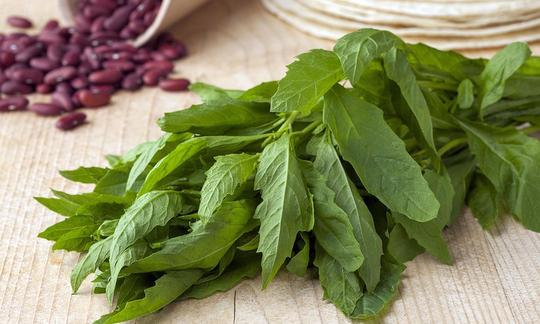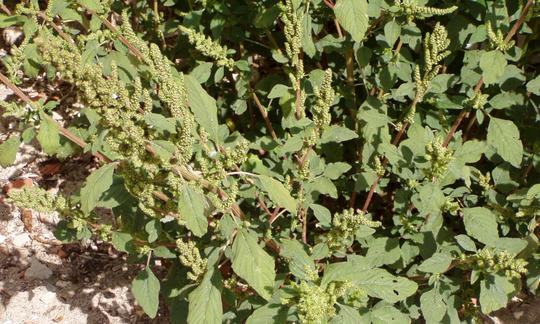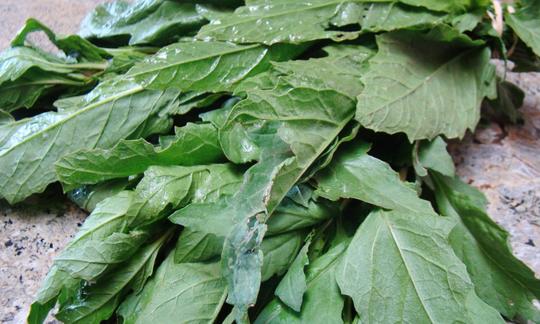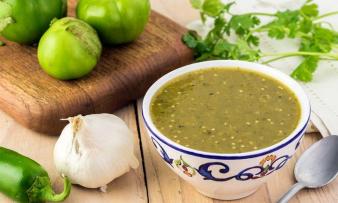Table of contents
Epazote ( Dysphania ambrosioides), also known as Mexican goosefoot, has a unique aroma and taste when raw and is an indispensable part of South American cuisine and medicine. It can also be found dried in organic quality.
Use in the kitchen
What is epazote? This is the name given to Mexican goosefoot, a herb from tropical America that was originally used as a vermifuge. The medicinal herb found its way into the kitchen as a spice - primarily in Mexico and Guatemala. Outside of these countries, epazote is little known. 1
Epazote gives off a scent that takes some getting used to. It is often compared to turpentine (resin) and creosote (tar oil). The taste of epazote is also unique and not for everyone. Raw, epazote has a slightly sharp, some say medicinal, taste with a resinous-ethereal to lemony-refreshing note. The taste can be imagined as a combination of oregano, anise, tarragon, spearmint and citrus fruits.
Epazote pairs well with black beans, pinto beans, cumin, garlic, onions, corn, chipotle peppers, and squash blossoms. A little juice from a lemon or lime enhances the flavor of the herb. Fresh leaf cilantro and epazote also complement each other well.
The herb (leaves and stems) is preferably used fresh, as it loses its aromatic diversity when dried. Unfortunately, Mexican goosefoot is rarely available fresh and raw in Europe. In addition, its aromatic substances do not withstand heating for long, which is why the herb should be added towards the end of the cooking process. For most dishes, 1-2 tablespoons of epazote spice are sufficient. Too much can overwhelm a dish and can also be dangerous (see chapter "Danger - Intolerances - Side Effects").
In Mexican cuisine, epazote is an indispensable ingredient in traditional chili sauces, corn dishes and bean dishes. Fresh or dried epazote leaves are used to flavor typical Mexican dishes such as enchiladas, quesadillas (e.g. with vegan cheese, zucchini flowers, sautéed onions and chili), sopes, mole de olla, tamales, chilaquiles or various soups (e.g. with black beans, lentils or mushrooms). Epazote is also an important ingredient in making the green salsa for chilaquiles (e.g. salsa verde made from pointed peppers and tomatillos). The herb is also often eaten with potatoes or fried rice.
In addition to being used as a spice and herb, the leaves are used to make a herbal or medicinal tea, also known as Mexican tea or Jesuit tea. The epazote seeds are also edible (only) when cooked. These should be soaked in water overnight before cooking and rinsed thoroughly to remove as many saponins as possible. 2
Vegan recipe for raw food salad with epazote
Ingredients (for 2 people): 2 tomatoes, 1 cucumber, 1 yellow bell pepper, 1 onion, juice of one lime, 1 tbsp rapeseed oil, 1 tsp chopped epazote (dried or raw, preferably organic), some salt andpepper.
Preparation: Wash the tomatoes, cucumber and sweet peppers, cut into cubes and place in a bowl. Peel the onion, chop roughly and add to the diced vegetables. Add the lime juice, oil and chopped epazote and stir well. Season with a little salt and pepper. Leave the vegan raw vegetable salad in the fridge for about 30 minutes and then serve.
Vegan recipe for bean soup with epazote
Ingredients (for 2 people): 1 cup black beans, 2 large potatoes, 2 onions, 2 teaspoons chopped epazote (dried or raw, preferably organic), 1 pinch dried sage, 1 pinch dried oregano, some salt and pepper.
Preparation: Cook the beans in a pot full of boiling water for about an hour until they are soft. In the meantime, peel the onions and potatoes and cut them into cubes. Add them to the water with the beans and cook until the potatoes are also soft. Add the epazote, sage and oregano and season with a little salt and pepper. Let the vegan bean soup simmer at a low temperature for about another 15 minutes before serving.
Tea preparation
ingredients (for 2 cups): 2 teaspoons epazote (dried, preferably organic), 2 cups water.
Preparation: Bring water to the boil in a pot. Add epazote. Reduce heat and let it steep for about 5-10 minutes. Strain the tea through a sieve. Sweeten with a little agave syrup if desired. Optionally, you can also add a little fresh lemon juice to give the epazote tea a refreshing note.
Vegan recipes with epazote (raw) can be found under the note: " Recipes that have the most of this ingredient ".
| Not only vegans or vegetarians should read this: Vegans often eat unhealthily. Avoidable nutritional errors. |
Purchasing - Storage
In Europe, it is difficult or even impossible to get hold of fresh Mexican goosefoot in stores. It is usually only available as a spice or as dried leaves in online shops (also in organic quality). You may find the dried herb in Mexican or South American grocery stores. You cannot buy Mexican goosefoot in major retailers such as Coop, Migros, Denner, Volg, Spar, Aldi, Lidl, Rewe, Edeka, Hofer, Billa etc. and organic supermarkets such as Denn's Biomarkt and Alnatura. If you want fresh herb, the best thing to do is grow it in your own garden (see the chapter "Growing your own").
What is a good epazote alternative? If you can't find epazote, you can use coriander, savory, Mexican oregano and lemon verbena as substitutes.
The availability of "Mexican glandular goosefoot" varies depending on the size of the store, catchment area, etc. If you are interested, click on our recorded food prices for the DA-CH countries (above under the ingredient image). There you will find current prices from various shopping options and the price development with just one click.
Storage tips The best way to store
fresh epazote is to place the stems in a glass of water, like cut flowers. Dried epazote should be stored in a dry place, protected from light. This way, the dried herb will last for several months.
Ingredients - Nutritional values - Calories
The energy content of epazote (raw) is low at 32 kcal/100g. With 0.52 g fat per 100 g, the herb is low in fat. Proteins (0.33 g/100g) and carbohydrates (7.4 g/100g) are also present in small amounts. 3
Raw epazote is rich in manganese. Its content of 3.1 mg/100g (155% of the daily requirement) is comparable to that of raw grape leaves (2.9 mg/100g) and cumin seeds (3.3 mg/100g). Cloves contain even more of the trace element, at 60 mg/100g. 3
215 µg of folate are found in 100 g of raw Mexican goosefoot (108% of the daily requirement). Raw spinach (194 µg/100g) and wakame (196 µg/100g) have a similar content. Yeast extract contains 3786 µg/100g, almost 18 times as much folate. 3
100 g of raw epazote also contains 275 mg of calcium (34% of the daily requirement). A similar amount can be found in fresh sage (266 mg/100g), peppermint (243 mg/100g) and rosemary (317 mg/100g). Fennel seeds are particularly rich in calcium, with 1196 mg/100g. 3
The complete ingredients of Epazote (raw), the coverage of the daily requirement and comparison values with other ingredients can be found in our nutrient tables. In the article Nutrients explained you will get a detailed insight into the topic.
Health effects
The Mexican goosefoot ( Dysphania ambrosioides) is a strongly aromatic herb that has a variety of health-promoting properties. The most well-known is the antiparasitic epazote effect against intestinal parasites such as roundworms, hookworms, small tapeworms and the single-celled parasite Entamoeba histolytica that causes amoebic dysentery. 1,4 Epazote also has antimicrobial, antibacterial, antifungal, insecticidal, anti-inflammatory and antinociceptive effects. 1, 4,5 A 2018 study also demonstrated activity against Leishmania ( Leishmania amazonensis). The bioactive substances ascaridol, carvacrol and caryophyllene oxide are responsible for this. 4
The herb can also provide relief from cramps and asthma and can help with catarrh thanks to its expectorant properties. It can be used externally for athlete's foot and insect bites. 1
Some studies demonstrate the antioxidant activity and antitumor effects of epazote essential oil. 4,5,6,7
Its use as a broad-spectrum anthelmintic is particularly widespread in veterinary medicine. The oil is obtained from both Dysphania ambrosioides (formerly Chenopodium ambrosioides) and Chenopodium ambrosioides var. anthelminticum, the latter having a higher content of the active ingredient. 1
Dangers - Intolerances - Side effects
An overdose of the medicinal plant leads to dizziness, vomiting and cramps and can even be fatal. Therefore, raw leaves should only be consumed in small quantities. 1 The essential oils contained can cause dermatitis or other allergic reactions. 1,8
Dysphania ambrosioides contains compounds that have been shown to impair mitochondrial function. The toxicity of Dysphania essential oil is associated with the presence of some of its main components, ascaridol, carvacrol and caryophyllene oxide. It is safe to use in small and controlled doses. 6
A 2021 study reported some cytotoxic effect of Dysphania ambrosioides essential oil on normal human liver cells by inducing apoptosis of these cells via the endogenous mitochondrial pathway. Considering this toxic effect of the essential oil on normal cells, it should be used with caution. 7
Pregnant and breastfeeding women, infants under three years of age and people suffering from liver or kidney disease should avoid consuming epazote and using the essential oil.1,6 In addition, treatments with epazote should only be carried out under medical supervision due to its toxicity.
Folk medicine - natural medicine
Mexican goosefoot is a very old and frequently used remedy for a variety of ailments. 6 The indigenous people of South America have been using the herb in traditional medicine for centuries. 7 It has also been used in Mexico and Central America for centuries to expel parasitic worms from the body. 2 Epazote, known there as Mkhinza, is also used in Moroccan folk medicine to treat various illnesses. 5
Epazote is considered a remedy for the gastrointestinal tract and related problems such as flatulence, stomach pain or colic. Applied externally, the herb has a wound-healing and detoxifying effect (e.g. for snake bites) and can provide relief from hemorrhoids. 8
In Cuba, Mexico and the Amazon, the herb is considered a magical plant and is used in traditional rituals. 2
Ecological footprint - animal welfare
The ecological footprint of a food depends on various factors. The type of agricultural cultivation (conventional vs. organic), average or seasonal or regional production, domestic production or import by truck, ship or plane, different types of packaging and whether the goods are fresh or frozen all play a decisive role. 9 Despite extensive research, we were unable to find any precise information on the CO2 footprint of the Mexican goosefoot. When shopping, it is ideal to look for regional goods or grow epazote yourself to avoid unnecessary transport routes. Products made from organic epazote are preferable to products from conventional cultivation because they are grown without the use of synthetic fertilizers and pesticides.
Animal protection - species protection
Mexican goosefoot serves as a food plant for caterpillars of various butterfly species, such as the leaf miner ( Coleophora sp.), the skipper ( Pholisora catullus and Staphylus mazans) and the owl butterfly ( Amyna octo and Rachiplusia ou). 10
Worldwide occurrence - cultivation
Epazote originates from tropical America (Central America and South America), but is now widespread throughout the world. 2,4,7 On the one hand, it was actively introduced as a foodstuff, and on the other hand, its seeds accidentally reached many countries (through contamination of seeds, mud, agricultural machinery or abiotic factors), where it subsequently became unintentionally naturalized and feral. 2
Epazote is considered one of the most successful plants to colonize both disturbed and agricultural areas on almost every continent. The plant quickly establishes itself in new areas, displacing native vegetation and disrupting native ecosystems. Dysphania ambrosioides is therefore a noxious weed in many places around the world. In areas of Italy, Spain, Greece, China, Vietnam, Cambodia, South Africa, Australia and Pacific islands, the neophyte is considered invasive. 2,4
In addition, the introduced epazote plants often affect agriculture. They disrupt agricultural crops such as cotton, coffee, beans, chickpeas, corn, rice and grapes. Dysphania ambrosioides is also a host to the fungal pathogen Erysiphe betae (powdery mildew), which can spread to tomato crops. 2
Found in the wild
The Mexican goosefoot grows in a wide range of habitats and climates, including tropical, subtropical and temperate regions and from sea level to 2000 m. It is native to Mexico, Central America and South America. It has been introduced and feral in some regions of Europe, the USA, the West Indies, Africa, Australia, Asia and the Pacific Islands. It is found in disturbed areas, on wastelands, on roadsides, on forest edges, in abandoned gardens, on pastures and on agricultural land. 2
Growing your own
Can you grow epazote yourself? The herb is easy to grow yourself. In April, sow the seeds in a weed-free, loosened bed at a seed depth of about 0.5 mm. The seeds need temperatures of around 20 °C to germinate. If the young plants grow too densely, they can be separated to a distance of about 20-30 cm. The plants should be watered well once a week, especially in hot and dry weather. The herb does not need fertilizer. The first leaves can be harvested from the end of May. 11 The herb can also be grown in a pot on the balcony.
It needs a sunny location and well-drained soil. 1
Further information
Dysphania ambrosioides is an intensely smelling plant that belongs to the Amaranthaceae family. It reaches a height of up to 1.2 m and has long, lanceolate leaves. In summer, the plant has tiny green flowers in panicles, followed by greenish-brown fruits, each with a black seed. 1
What is Epazote in English? The name Epazote comes from Nahuatl, a language spoken by the indigenous peoples of Mexico and Central America. The compound word epazōtl (from epatl and tzotl) means something like "skunk smell" or "skunk sweat" and is intended to refer to the intense smell of the plant. 12
Alternative names
Is the word Epazote German? The Spanish name Epazote is also used in German. However, spelling mistakes often creep in, such as Epezote, Epizote, Espasote, Epazite, Epazotr, Epazotes, Espazote, Epatote, Epazpte or Epazotw.
There are numerous alternative names for epazote, such as Mexican glandular goosefoot, fragrant goosefoot, Jesuit tea, Mexico glandular goosefoot, Mexican grape tea, Mexican tea herb, tea goosefoot, ragweed, fragrant goosefoot, Mexican goosefoot, Cappadocia oak, Jesuit tea, Merwet, Carthusian tea and Breslau tea.
In English the herb is often called epazote, wormseed or Mexican tea.
The herb is known by the Latin names Dysphania ambrosioides and Chenopodium ambrosioides, the genus name was changed from Chenopodium to Dysphania.
Other uses
The essential oils extracted from the leaves are used as fragrance components in creams, perfumes and soaps. Because the herb contains terpene compounds, it is also used as an incense against mosquitoes and added to fertilizers to inhibit the development of insect larvae. 1,2
Due to its antioxidant activity, epazote and its oil are also used as natural antioxidant additives in food processing to extend the shelf life and improve the sensory properties of foods. 7
Bibliography - 12 Sources
| 1. | Bown D. The Royal Horticultural Society. Encyclopedia of Herbs & their Uses. Dorling Kindersley: London; 1995: 55, 106, 259-60. |
| 2. | Cabidigitallibrary org Dysphania ambrosioides (Mexican tea). |
| 3. | USDA United States Department of Agriculture. |
| 4. | Monzote L, Geroldinger G, Tonner M, Scull R, De Sarkar S, Bergmann S, u. a. Interaction of Ascaridole, Carvacrol, and Caryophyllene Oxide from Essential Oil of Chenopodium ambrosioides L. with Mitochondria in Leishmania and other Eukaryotes. Phytother Res. 2018;32(9):1729–40. |
| 5. | Kandsi F, Elbouzidi A, Lafdil FZ, Meskali N, Azghar A, Addi M, u. a. Antibacterial and Antioxidant Activity of Dysphania ambrosioides (L.) Mosyakin and Clemants Essential Oils: Experimental and Computational Approaches. Antibiotics (Basel). 2022;11(4):482. |
| 6. | Dagni A, Hegheș SC, Suharoschi R, Pop OL, Fodor A, Vulturar R, u. a. Essential Oils from Dysphania genus: Traditional Uses, Chemical Composition, Toxicology, and Health Benefits. Front Pharmacol. 2022;13:1024274. |
| 7. | Wang XY, Hao JM, Ren QR, Li HY, Wu JS, Zhu XH, u. a. Cytotoxicity and Apoptosis induced by Chenopodium ambrosioides l. Essential Oil in Human Normal Liver Cell Line L02 via the Endogenous Mitochondrial Pathway rather than the Endoplasmic Reticulum Stress. Int J Environ Res Public Health. 2021;18(14):7469. |
| 8. | Pfaf org Chenopodium ambrosioides - L. |
| 9. | Reinhardt G, Gärtner S, Wagner T. Ökologische Fussabdrücke von Lebensmitteln und Gerichten in Deutschland. Institut für Energie- und Umweltforschung Heidelberg ifeu. 2020;1-22. |
| 10. | Data Natural History Museum UK Chenopodium ambrosioides. |
| 11. | Derkleinegarten de Epazote (Jesuitentee) Anbau im Garten – ein interessantes Würzkraut. |
| 12. | Potawale SE, Luniya KP, Mantri RA, Mehta UK, Waseem MS, Vetal YD, Deshmukh RS. Chenopodium ambrosioides: An Ethnopharmalogical Review. Pharmacologyonline (2). 2008: 272-286. |













Comments